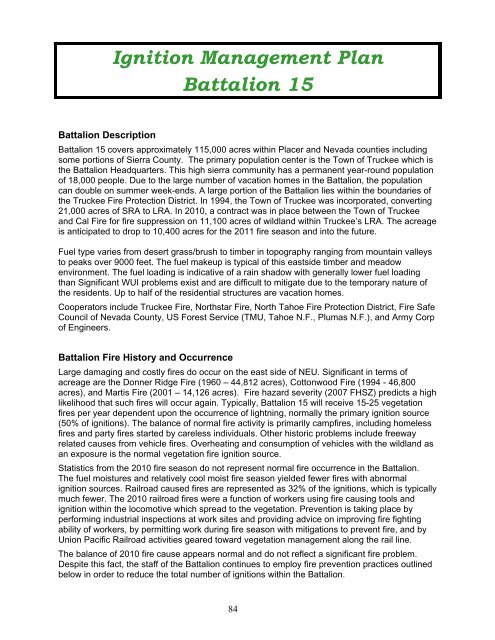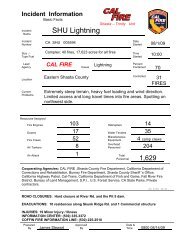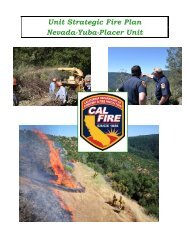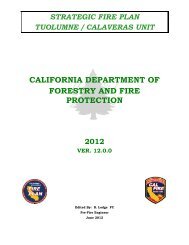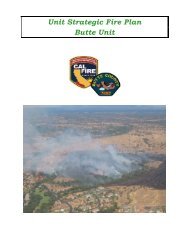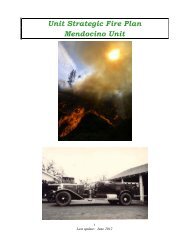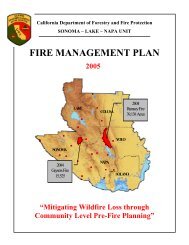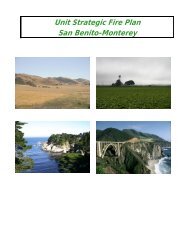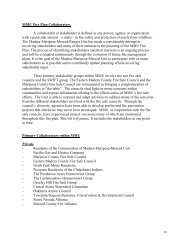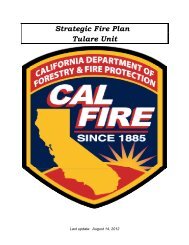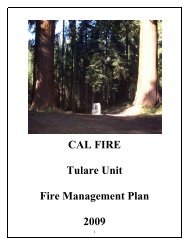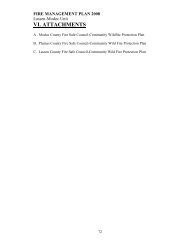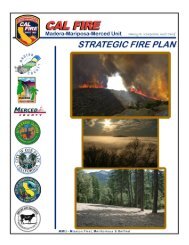Nevada-Yuba-Placer Strategic Fire Plan 2011 - Board of Forestry ...
Nevada-Yuba-Placer Strategic Fire Plan 2011 - Board of Forestry ...
Nevada-Yuba-Placer Strategic Fire Plan 2011 - Board of Forestry ...
You also want an ePaper? Increase the reach of your titles
YUMPU automatically turns print PDFs into web optimized ePapers that Google loves.
Ignition Management <strong>Plan</strong><br />
Battalion 15<br />
Battalion Description<br />
Battalion 15 covers approximately 115,000 acres within <strong>Placer</strong> and <strong>Nevada</strong> counties including<br />
some portions <strong>of</strong> Sierra County. The primary population center is the Town <strong>of</strong> Truckee which is<br />
the Battalion Headquarters. This high sierra community has a permanent year-round population<br />
<strong>of</strong> 18,000 people. Due to the large number <strong>of</strong> vacation homes in the Battalion, the population<br />
can double on summer week-ends. A large portion <strong>of</strong> the Battalion lies within the boundaries <strong>of</strong><br />
the Truckee <strong>Fire</strong> Protection District. In 1994, the Town <strong>of</strong> Truckee was incorporated, converting<br />
21,000 acres <strong>of</strong> SRA to LRA. In 2010, a contract was in place between the Town <strong>of</strong> Truckee<br />
and Cal <strong>Fire</strong> for fire suppression on 11,100 acres <strong>of</strong> wildland within Truckee’s LRA. The acreage<br />
is anticipated to drop to 10,400 acres for the <strong>2011</strong> fire season and into the future.<br />
Fuel type varies from desert grass/brush to timber in topography ranging from mountain valleys<br />
to peaks over 9000 feet. The fuel makeup is typical <strong>of</strong> this eastside timber and meadow<br />
environment. The fuel loading is indicative <strong>of</strong> a rain shadow with generally lower fuel loading<br />
than Significant WUI problems exist and are difficult to mitigate due to the temporary nature <strong>of</strong><br />
the residents. Up to half <strong>of</strong> the residential structures are vacation homes.<br />
Cooperators include Truckee <strong>Fire</strong>, Northstar <strong>Fire</strong>, North Tahoe <strong>Fire</strong> Protection District, <strong>Fire</strong> Safe<br />
Council <strong>of</strong> <strong>Nevada</strong> County, US Forest Service (TMU, Tahoe N.F., Plumas N.F.), and Army Corp<br />
<strong>of</strong> Engineers.<br />
Battalion <strong>Fire</strong> History and Occurrence<br />
Large damaging and costly fires do occur on the east side <strong>of</strong> NEU. Significant in terms <strong>of</strong><br />
acreage are the Donner Ridge <strong>Fire</strong> (1960 – 44,812 acres), Cottonwood <strong>Fire</strong> (1994 - 46,800<br />
acres), and Martis <strong>Fire</strong> (2001 – 14,126 acres). <strong>Fire</strong> hazard severity (2007 FHSZ) predicts a high<br />
likelihood that such fires will occur again. Typically, Battalion 15 will receive 15-25 vegetation<br />
fires per year dependent upon the occurrence <strong>of</strong> lightning, normally the primary ignition source<br />
(50% <strong>of</strong> ignitions). The balance <strong>of</strong> normal fire activity is primarily campfires, including homeless<br />
fires and party fires started by careless individuals. Other historic problems include freeway<br />
related causes from vehicle fires. Overheating and consumption <strong>of</strong> vehicles with the wildland as<br />
an exposure is the normal vegetation fire ignition source.<br />
Statistics from the 2010 fire season do not represent normal fire occurrence in the Battalion.<br />
The fuel moistures and relatively cool moist fire season yielded fewer fires with abnormal<br />
ignition sources. Railroad caused fires are represented as 32% <strong>of</strong> the ignitions, which is typically<br />
much fewer. The 2010 railroad fires were a function <strong>of</strong> workers using fire causing tools and<br />
ignition within the locomotive which spread to the vegetation. Prevention is taking place by<br />
performing industrial inspections at work sites and providing advice on improving fire fighting<br />
ability <strong>of</strong> workers, by permitting work during fire season with mitigations to prevent fire, and by<br />
Union Pacific Railroad activities geared toward vegetation management along the rail line.<br />
The balance <strong>of</strong> 2010 fire cause appears normal and do not reflect a significant fire problem.<br />
Despite this fact, the staff <strong>of</strong> the Battalion continues to employ fire prevention practices outlined<br />
below in order to reduce the total number <strong>of</strong> ignitions within the Battalion.<br />
84


